There are lots of solutions for tracing an embroidery pattern to fabric. There are printable transfer papers and iron-on patterns.
Or there is the low tech method of simply tracing your pattern by hand to fabric. I’m so low tech, that I typically trace by taping pattern and fabric in a sunny window or if I’m tracing on white… sometimes just on the kitchen table. I’d love to have a light box but I until then, the window is just fine.
I’ve used different pens depending. Here are the three pens I’ve used for tracing my patterns and the pros and cons of each:
a. Fine Point Brown Permanent Pigma Pen
For my Make it Do embroidery that I stitched this summer, I traced the pattern with a Brown Pigma Pen. This is what my mom uses and taught me to use. I love using a brown Pigma for lots of reasons. Just be sure to buy a light brown Pigma pen. I choose a .25 mm fine point pen- has an “01” on the end.
Pros:
- Pigma pens are crisp and easy to write on fabric
- The very fine point allows for fine detail
- Can be ironed or gotten wet without disturbing the pattern
- I love it for red work especially
Cons:
- Permanent- so a mistake in tracing the pattern is not fun
- Because it’s permanent, you need to be more accurate with stitching (like when doing a satin stitch)
- Will blob a little here and there – but never enough to show past my stitching
b. Water Soluble Pen
My go to pen when letting the kids do the tracing or when tracing for kids… a Fine Water Soluble Marker is easy to trace with and even easier to make disappear. I love to add fusible fleece to the back of my embroidery projects. The fleece on the back makes for much crisper, more accurate stitches, since the fabric doesn’t pull and stretch as much. I apply the fleece to most of my projects that are for pillows or framing… just not a dishtowel for obvious reasons. Since the water soluble pen is not heat sensitive you can iron on the fleece after tracing the pattern- just be sure to turn off the steam.
Pros:
- Very easy and smooth to trace with- my 9 year old daughter traced the sweet elephant embroidery above
- SO, SO easy to make totally disappear with just a spray of water from a water bottle- also perfect for kids with stitches that are exactly accurate!
- Not sensitive to heat
Cons:
- Much more difficult to draw an intricate design- because of thickness of the point and the fact that it bleeds more
- Need to be careful around water. My daughter spilled a cup of water while she was embroidering…. and, so sad, her pattern was gone. Since we already had fusible fleece on the back… retracing wasn’t so easy.
c. Heat Disappearing Pen
This is a new fangled pen- at least for me. It’s a Pilot FriXion Pen. Which is a fine ball point pen. I used it for my latest Halloween embroidery that I’m working on now. Here’s how it works.
Simply write on the fabric. And when you are ready for the writing to disappear. Apply a hot iron….
And voila! It disappears.
Pros:
- Can draw a fairly intricate design… though not as easy as the super fine point Pigma
- Not permanent
- SO, SO easy to make disappear with just a hot iron
Cons:
- I can’t iron on the fleece at all… unless I want my work to disappear before my eyes.
- I’m not super fond of how it writes on fabric… the ballpoint can be thrown from your intended line ever so slightly by the weave of the fabric.
- You can’t iron your fabric if it gets wrinkled or you need to press a seam.
So there’s my take on the low tech options for tracing an embroidery pattern. Do you embroider? What’s your favorite method? I think I will continue to use all three types of pens… depending on my needs and my mood.
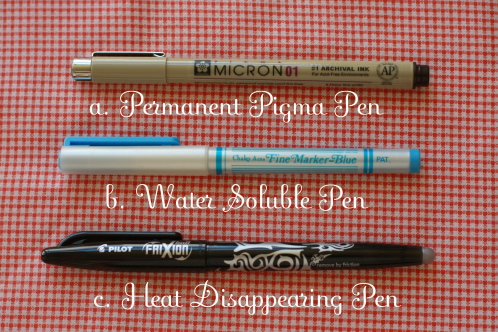
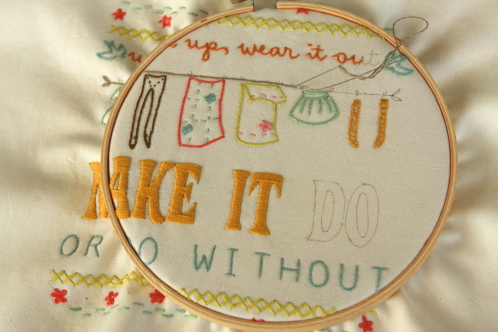
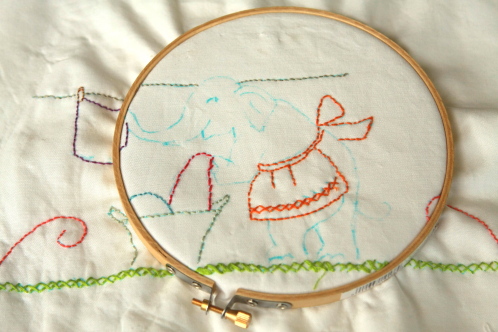
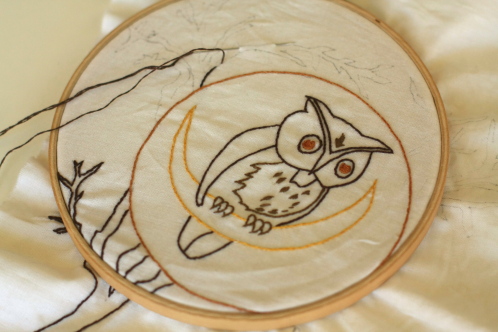
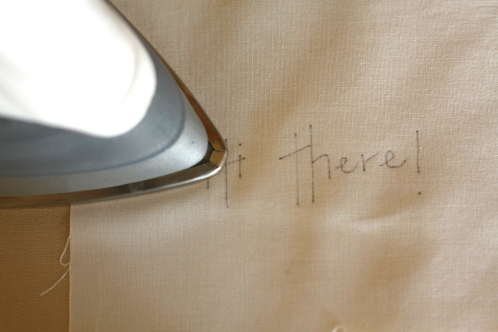
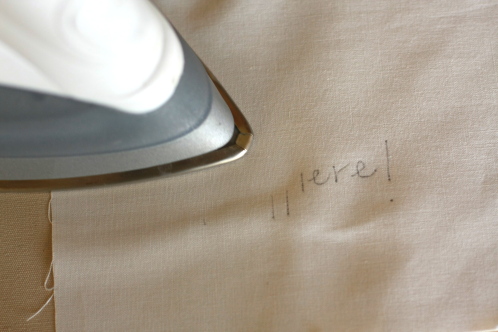
I am not an embroiderer (yet….I seem to wind up trying everything eventually!) but this is such an informative post. I love your blog. So many useful ideas, not to mention the beautiful things you create. I’ve subscribed for a while but this is my first time commenting.
~Heather
Of late, I’ve been using the FriXion pen. Twice now, I’ve accidentally iron my whole tracing off forgetting while needing to iron seams… I use the other 2 pens also, depending like you say. Thanks for the summary. I agree with all your points. I LOVE embroidery so very much.
Thanks for the info. I am wanting to do some embroidery for Christmas presents and was thinking about it today. Guess I need to figure out what I want to use. Any other tips?
Great information. I have been using a pencil lately, but it rubs off as I’m stitching sometimes. I’ve never tried the Pigma. I’ll have to try that one.
Where do you get your embroidery patterns?
I need to jump in here with my 2 cents about the Frixion pens…although they disappear when heat is applied…the ink will return if the item gets cold. I have done some testing and if you put the fabric in the freezer it will come back. Granted we aren’t all throwing our work in the freezer, but some of us live in a cooler climate and items that might get stored in a loft or basement might be exposed to cooler temperatures and therefore might reveal the ink. It doesn’t wash out either..in fact the heat almost heat sets it and it can’t be washed out.
As always… test these pens before using. Hope that helps :o)
Thank you so much for sharing that Jane! I’m going to experiment with the freezer and my Frixion pen today too. It also makes me wonder, some of our embroideries may be passed down the generations. What the ink will do in 100 years from now?
So for those of us living up north here in Canada, don’t use it on anything that might be worn in winter! You could be walking to work with your beautiful embroidered blouse collar changing colour!
Even as you are delivering presents, you’d need to do those ones first so they aren’t left in a freezing car while you make your rounds.
I really like using the iron on transfer pencils. They aren’t quite as easy to get the fine details, but since you are tracing your design on the paper itself, you can make mistakes without ruining your fabric.
I am going to sound very low tech, but I just use a good old No.2 pencil from my desk drawer. I can iron it and my stitches cover it well. As a plus, you can even lightly erase without damaging most fabrics I have used.
In my experiences, the blue water soluble pens DO leave a heat sensitive mark. If you iron them, they likely will become permanent blue markings. Quilters frequently use the blue pens, and we are ALWAYS cautioned about applying heat to that ink. Test this out and see what your experiences are. Perhaps we are not talking about the same type of blue pen, but I would hate for someone to find they can not remove the markings.
Hi Mary Ellen, I have ironed fusible web many times to the back of my embroideries traced with a water soluble pen (so the hot iron IS directly on the fabric with the tracing), then later used water to remove any blue marks that might be left showing. I’ve never had any problems with the marks being permanent. I would hate to give advice that leads anyone astray though! I may add a caution to my bullet points just in case.
I’d worry about using blue pen on anything that won’t be fully washed (not just rinsed). The darned stuff shows up again when you least expect it. Especially bad as a blue haze spread all over your piece!
great info! I like to use Saral transfer paper. It comes in many different colors, and works sort of like carbon paper. I place the transfer paper between my design and the fabric, retrace the design, and the color of the transfer paper is on the fabric! It’s great because I can use the white paper to get a design on really dark fabrics. It is wax-free, will rinse out, and will only slightly fade while sewing (depending on how much you touch it.)
I heard a rumor, or a quote from someone else (lasewista) That the frixion pen will come back when cold. I haven’t tried it but the package says that it will reapear when palced below 30 something degrees. It would be fun to try. I might go try that now. Let you know what happens.
Hey! I found you through a pin on Pinterest and started looking through your blog — you’ve got some really great tips and projects. I loved the owl embroidery pattern that you shared and this post on different means of marking is excellent (and I pinned it, too). Thanks for sharing! (And Happy Valentine’s Day!) :)